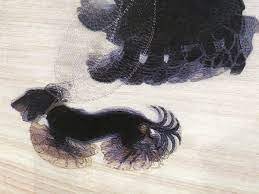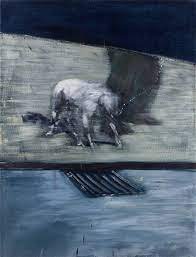13 FAMOUS DOG PAINTINGS
Art has always had the power to capture the essence of life and the beauty of our world. It's no surprise that some of the most cherished and celebrated pieces of art feature our beloved pets. Throughout art history, renowned artists have captured the charm, personality, and loyalty of animals, immortalising them on canvas. In this blog, we'll explore famous pet portraits from various periods and the significance they hold in the world of art.
1. George Stubbs, White Poodle in a Punt, c.1780, oil on canvas
White Poodle in a Punt, holds significant historical and cultural value as a pet portrait. Painted around 1780, this work represents more than just an exquisite rendering of a dog in a picturesque setting. It serves as a testament to the evolving relationship between humans and their pets during the 18th century. In this period, the aristocracy developed a growing affinity for pets, and the poodle in the painting signifies the breed's role as both a status symbol and a cherished companion. Stubbs' meticulous attention to detail showcases the dog's significance in the lives of its owners, shedding light on the emotional and cultural connections between humans and their pets during the Enlightenment era. This portrait offers a window into the changing dynamics of pet ownership and the increasing importance of animals as part of the family, making it an essential artifact in the history of the human-animal bond.
2. Theodore Gericault, Bulldog, c.1815, oil on canvas
Bulldog, is a remarkable representation of this breed that holds both visual and symbolic significance. Beyond being a striking visual study of the bulldog's muscular form and distinctive features, the portrait carries a deeper meaning. In the early 19th century, bulldogs were often seen as symbols of tenacity and strength. Gericault's portrayal may reflect the prevailing admiration for these qualities during the tumultuous era in which he lived. Additionally, the painting's creation during the Romantic period, with its fascination for the untamed and the elemental, might also suggest a connection between the bulldog's rugged appearance and the spirit of the times.
3. Paul Delaroche, Portrait of Belcher, an English Bulldog, 1832, oil on panel
Portrait of Belcher, an English Bulldog, holds both visual and symbolic significance. This pet portrait, created in the 19th century, represents the breed's unique qualities, emphasising its muscular and distinctive physique. It also reflects the era's fascination with the representation of pets as companions and loyal friends. The bulldog, known for its tenacity and strength, embodies qualities admired during a time marked by social and political upheaval. Delaroche's portrayal not only showcases his artistic mastery but also captures the charm and appeal of the bulldog as a symbol of loyalty and steadfastness in an ever-changing world, making it a meaningful representation of the bonds between humans and their animal companions.
4. Edouard Manet, Tama, The Japanese Dog, 1875, oil on canvas
Manet’s Tama, the Japanese Dog, is a captivating pet portrait that holds unique significance. In this work, Manet captures a sense of cultural exchange and curiosity that marked the late 19th century. Tama, the Japanese spaniel depicted in the painting, represents the fascination with Japanese art and culture that had swept through Europe during that period, often referred to as "Japonism." The dog's exotic name and distinctive appearance reflect the influence of Japanese aesthetics on European art. Beyond its cultural implications, the portrait exemplifies Manet's skill in portraying the character and individuality of his subject. "Tama" thus embodies a fusion of artistry, cultural cross-pollination, and the timeless appeal of pets as beloved companions, offering a multifaceted view of the era's artistic and sociocultural currents.
5. Pierre-Auguste Renoir, Tama, The Japanese Dog, 1876, oil on canvas
Renoir’s Tama, The Japanese Dog, is a remarkable pet portrait that carries both visual and cultural significance. Painted by Renoir in the late 19th century, this work encapsulates the era's fascination with Japanese aesthetics and the broader artistic movement known as "Japonism." The inclusion of the dog named "Tama" with Japanese characteristics reflects the influence of Japanese culture on European art during this time. Renoir's brushwork and the dog's charming presence not only pay tribute to this cross-cultural exchange but also emphasise the enduring appeal of pets as beloved companions. "Tama, The Japanese Dog" thus serves as a testament to the interplay of cultural influences in the art world and the timeless connection between humans and their animal friends.mastery of the Impressionist style.
6. Pablo Picasso, Dog, 1893-94, cut out paper
Picasso’s Dog, 1893-94, created in during his early years as an artist, is a significant piece in his career. This pet portrait showcases Picasso's early experiments with different artistic styles, reflecting the transition from his academic training to the development of his signature modernist approach. The painting captures a level of emotion and sensitivity that is not often associated with Picasso's later, more abstract works. The dog, portrayed with a sense of empathy and vulnerability, symbolises the artist's deep connection to his subjects and anticipates his later exploration of complex emotional themes.
7. Henri de Toulouse-Lautrec, Bouboule: MME. Palymyre's Bulldog , 1897, pastel drawing on board
Bouboule: MME. Palymyre's Bulldog , is a charming pet portrait that holds significance in its portrayal of the bond between humans and their animals, as well as the artist's unique approach to capturing character. This painting, from the late 19th century, depicts the bulldog Bouboule, owned by Madame Palmyre, with remarkable attention to detail and a sense of affection. Beyond the aesthetic appeal, it symbolises the intimate companionship people had with their pets during the Belle Époque in France. Toulouse-Lautrec's portrayal of Bouboule highlights the dog's individuality and character, much like a human portrait, making it a significant representation of the growing recognition of pets as cherished members of the family. This portrait showcases the artist's ability to infuse humanity and personality into his subjects, even those of the four-legged variety, offering a delightful insight into the culture and emotions of the time.
8. Francis Barraud, His Master's Voice, c.1898-99
His Master's Voice, is an iconic pet portrait that holds profound cultural and historical significance. Created in the early 20th century, it depicts a dog listening intently to a phonograph, as the title suggests. This image became the logo for the famous RCA Victor record label and later for the HMV (His Master's Voice) brand. Beyond its commercial success, the painting symbolises the deep emotional connection between humans and their pets, capturing the dog's loyalty and attentiveness. The work is an enduring representation of the universal bond between humans and their animal companions, emphasising the role of sound and music in reinforcing that connection. The image has become a symbol of nostalgia, fidelity, and the enduring power of music to touch the human soul, making it a significant and beloved cultural icon.
9. Giacomo Balla, Leash in Motion, 1912, oil on canvas
Leash in Motion, is a significant pet portrait that embodies the essence of the Italian Futurist movement. Created in the early 20th century, this painting captures the dynamic energy and pace of modern life, breaking away from traditional artistic conventions. It represents not just the physical movement of a dog on a leash but also the broader idea of capturing the spirit of the rapidly changing industrial and urbanised world. The work symbolises the Futurist desire to embrace modernity and convey the sense of movement and speed inherent in contemporary society. It offers a unique perspective on the relationship between humans and their pets, redefining the traditional pet portrait by infusing it with the spirit of innovation and the dynamic rhythms of the modern age.
10. Francis Bacon, Man with Dog, 1953, oil on canvas
Man with Dog, is a powerful and emotionally charged pet portrait created in the 1950s. Known for his intense and often disturbing works, Bacon's portrayal of a man and his dog departs from traditional pet portraits. The painting delves into themes of isolation and existential anguish, as the dog seems to mirror the man's inner turmoil. The intense brushwork and distortion of forms reflect the profound emotional tension within the human-animal relationship. "Man with Dog" is a profound exploration of the complexities of human existence and the connection between individuals and their pets, offering a stark and introspective view of the existential dilemmas that troubled Bacon and his generation in the post-war period.
11. Roy Lichterstein, Grrr!, 1965, oil and magna on canvas
Grrr!, is a pet portrait that exemplifies his iconic Pop Art style. Painted in the 1960s, it takes an entirely new approach to the traditional pet portrait. The bold use of Ben-Day dots and comic book-inspired lines creates a sense of vibrant energy and playfulness. The title "Grrr!" evokes the growling or barking sound associated with dogs, and the image humorously captures the exuberance and vitality of a pet's presence in a household. Lichtenstein's work both celebrates and satirises popular culture, and "Grrr!" is a testament to his ability to transform the mundane into high art. It signifies the intersection of art and everyday life, with pets becoming a significant part of the American domestic landscape during the mid-20th century.
12. Andy Warhol, Amos, 1976, oil on canvas
Amos, 1976, is a pet portrait that reflects his iconic Pop Art style. Created in the 1970s, this portrait exemplifies Warhol's fascination with celebrity and the cultural impact of fame. In this case, "Amos" serves as a representation of the everyday, elevating a common domestic pet to a celebrity status. By using his signature vibrant colours and repetition, Warhol challenges traditional notions of portraiture, demonstrating how the subject's identity can be both celebrated and obscured by fame. "Amos" signifies Warhol's ability to transform the ordinary into extraordinary and serves as a commentary on the intersection of art, fame, and consumer culture in the latter half of the 20th century
13. Ben Quilty, Betsy Sugar Ham Tongue, 2017, oil on polyester
Betsy Sugar Ham Tongue, is a unique and playful pet portrait that captures the essence of both the artist's style and the subject's character. Created in the 21st century, this painting is part of Quilty's distinctive exploration of animal subjects, marked by bold brushwork and a contemporary aesthetic. "Betsy Sugar Ham Tongue" represents more than just a likeness of a pet; it is an embodiment of the emotional connection between humans and their animal companions. The affectionate and whimsical title adds to the overall charm, reflecting the endearing and humorous moments shared between pet and owner. Quilty's work celebrates the joy, love, and individuality of pets in our lives, symbolising the enduring appeal of the animal-human bond in the modern era.
In conclusion, pet portraits throughout history have showcased the remarkable talent of artists in representing the charm, character, and significance of animals in our lives. These celebrated artworks provide a fascinating window into the evolution of pet portraiture and its enduring appeal in the world of art.
ABOUT THE WRITER
Rachel Wolfe is a pet portrait artist based in Hobart, Tasmania. She specialises in animal art and pet portrait paintings, capturing the unique personality and essence of each pet with a keen eye for detail and a deep love for animals. Rachel offers commissioned works and gift vouchers, making her pet portraits the perfect present for any pet lover.
Rachel is also currently pursuing a Bachelor of Fine Arts at the University of Tasmania, further honing her artistic skills and broadening her creative horizons.
To learn more about Rachel's work or to commission a custom pet portrait visit www.endearportraiture.com.au and to learn more about Rachel’s fine arts practice visit www.rachelwolfe.com.au or follow her on social media.














